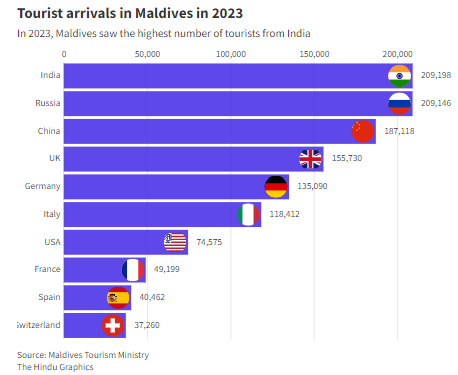Syllabus: GS 3/Economy
| In Context The Maldives Association of Tourism Industry (MATI) ‘strongly condemned’ the derogatory remarks made on PM Modi’s post on Lakshadweep to promote Tourism . |

About India’s tourism Economy
- India is geographically diverse and offers a variety of cultures that come with its own experiences, making it one of the leading countries in terms of international tourism expenditure.
- The Tourism and Hospitality sector is an integral part of the Make in India initiative, a vital economic catalyst for job creation and rapid development.
- India has always been a popular destination for travellers exploring spiritual enlightenment and self-discovery.
- For centuries many great foreign travellers visited India and shared their experiences in the form of memoirs, travelogues, poetry and books, as Megasthenes, Hiuen-Tsang, Marco Polo, and Fa-Hien.
Potential
- India is a large market for travel and tourism. It offers a diverse portfolio of niche tourism products – cruises, adventure, medical, wellness, sports, MICE, eco-tourism, film, rural and religious tourism.
- The Indian coastline is one of the longest in the world, adding up to 7,516 km including the mainland, the islands of Andaman and Nicobar, and Lakshadweep.
- This vast coastline is dotted with beach destinations both popular and unknown.
- Popular destinations are Goa, Kerala, and the Andaman and Nicobar Islands
- India has been recognized as a destination for spiritual tourism for domestic and international tourists.
- As the birthplace to four major world religions, i.e., Hinduism, Buddhism, Sikhism and Jainism, India can truly claim to be the world’s spiritual beacon.
What is the Significance of the Tourism Sector in India?
Economic Benefits: Tourism generates revenue through the sale of goods and services to tourists.
Cultural Exchange: visitors from different parts of the world can learn about and experience India’s diverse cultures and traditions
Preservation of Cultural Heritage: such as temples, forts, and palaces by providing the funds
Social Benefits: benefits to local communities, such as through the creation of employment opportunities
Environmental Benefits: such as through the development of eco-tourism initiatives
Challenges
- The major issues faced by the tourism industry relate to
- entry formality (visa),
- Lack of Human Resource
- Unsustainable Tourism: In India, especially in the Himalayan regions,
- safety and security of tourists,
- foreigner harassed by locals
- Pollution and Climate Change: Our major tourist sites (heritage sites) are also affected by pollution
- lack of tourism infrastructure,
- lack of cleanliness and hygiene in tourist spots,
- lack of connectivity,
- high and multiple taxation, etc.
Initiatives by India To Boost Tourism
- In the Union Budget 2023-24, US$ 290.4 million has been allocated to the Ministry of Tourism.
- Swadesh Darshan Scheme to develop a complete package of 50 tourist destinations for providing a wholesome tourism experience by facilitating physical, digital and virtual connectivity, availability of tourist guides and tourist security.
- Ek Bharat Shreshtha Bharat
- Development of tourist circuits under PRASHAD Scheme
- The Ministry of Tourism has partnered with the Quality Council of India (QCI), to assist the Hospitality Industry in their preparedness to continue operations safely and mitigate risks arising out of the COVID-19 pandemic through an initiative called SAATHI (System for Assessment, Awareness and Training for Hospitality Industry).
- The Ministry of Tourism has also designated the Year 2023 as the ‘Visit India’ year, an invitation to the world to witness the splendor and magnificence that our nation has to offer.
- India welcomes 100% Foreign Direct Investment (FDI) in the tourism industry under the automatic route.
- Establishing Multilateral And Bilateral Relations with countries. In 2023, India hosted the SCO Tourism Ministers’ Meeting (TMM) in Kashi (Varanasi).
- Ministry of Tourism has launched the Travel for LiFE Initiative. Travel for LiFE aims to promote sustainable tourism in the country
Conclusion and Way Forward
- Concept of ‘Atithi Devo Bhava’ and multitude of tourism and religious destinations-
- In India, we believe in the concept of ‘Atithi Devo Bhava’—a guest is treated as God.
- The rich cultural heritage, cuisine, the friendly and welcoming attitude of most Indians towards foreigners help in attracting more visitors to India.
- Tourism is an important source of foreign exchange in India similar to many other countries.
- There is a need to do a lot towards ease of visas, direct flights, and more connectivity to lower the cost of travel. Skilling is another important aspect which needs focus.
- Tourism sector should not only be centred on preserving rich heritage but also in creating world class infrastructure for tourism,
- It is now high time to work for the betterment of this sector so that from the upcoming years the number of foreign tourists may increase, and more people will be able to know about India’s culture.

Pingback: India-Maldives Relations UPSC Mains Explained - Shiv IAS- Best Website Source For Comprehensive Daily Current Affair and Editorial Analysis For UPSC CSE Exam Preparation